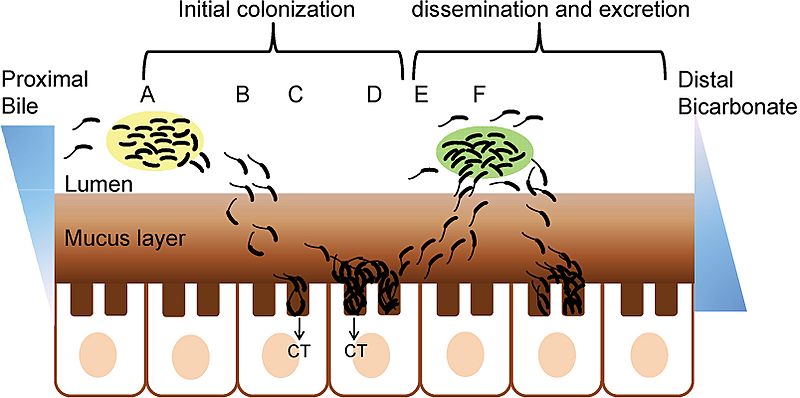Image: Cholera role of biofilm in intestinal colonization

Description: "Fig 3 Model for the role of biofilm in intestinal colonization. (A) Cholera Vibrios can enter the small intestine as planktonic cells or embedded in a biofilm matrix, represented by a pale yellow shade. A fraction of Vibrios detach from the biofilm into the lumen. (B) Bile in the lumen acts as a repellent. Vibrios interact with the protective mucus coat and penetrate the mucus layer. (C) Vibrios interact with the villi. Bacterial interaction with the villi could involve iterative weak attachments that result in a more permanent adherence facilitated by TCP and other adhesins. Low bile, high bicarbonate, and cessation of motility in the proximity of the villi favor the expression of TCP and CT. (D) Expression of TCP and unknown factors promote microcolony formation along the villous axis and the crypts. (E) At high cell density, activation of HA/protease and motility by quorum sensing and RpoS promotes detachment. (F) Detached Vibrios are shed back into the luminal compartment. High bile concentration in the lumen enhances the c-di-GMP pool and favors biofilm formation. A fraction of detached Vibrios respond to bile stress by forming biofilms in vivo, indicated by Vibrio aggregates embedded in a pale green shade. Repetition of steps A through E spreads the infection along the small intestine. A mixture of V. cholerae planktonic cells, biofilm-like aggregates, and degraded mucus is excreted in the cholera stool."
Title: Cholera role of biofilm in intestinal colonization
Credit: https://doi.org/10.1371/journal.pntd.0004330.g003
Author: Anisia J. Silva , Jorge A. Benitez
Usage Terms: Creative Commons Attribution 4.0
License: CC BY 4.0
License Link: https://creativecommons.org/licenses/by/4.0
Attribution Required?: Yes
Image usage
The following page links to this image:

